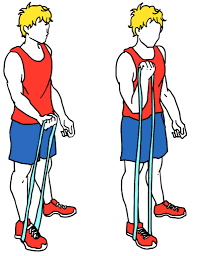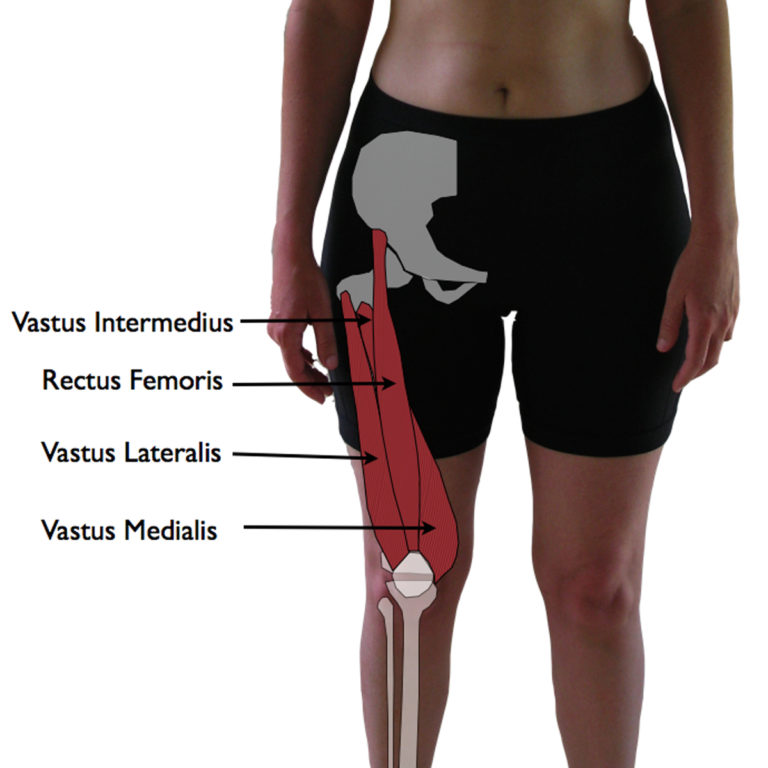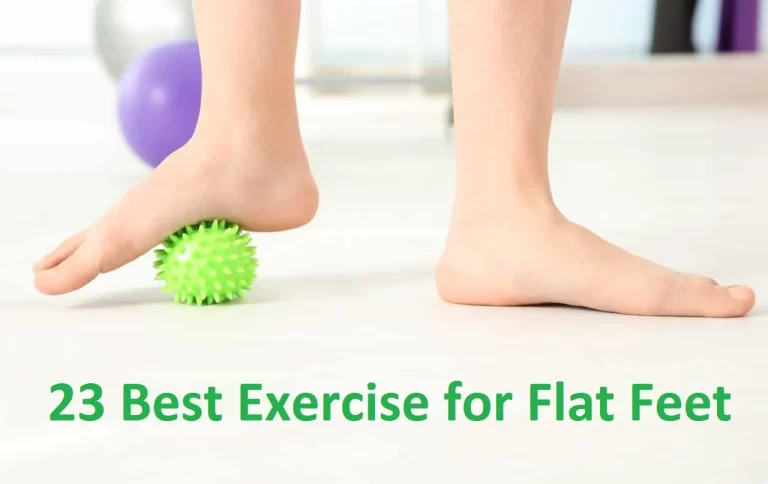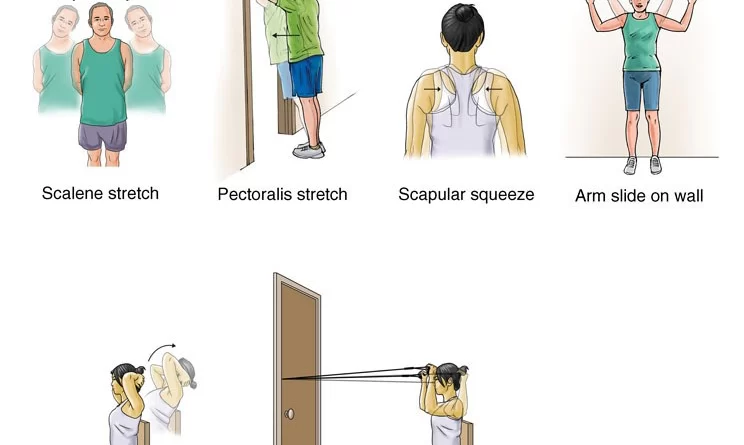Dorsiflexors muscle Exercise
Table of Contents
What is dorsiflexor muscle exercise?
- Dorsiflexor muscle exercise helps to improve strength, mobility, and flexibility of the ankle joint & its surrounding muscles & tendons. When the ankle is flexible, you have a greater range of motion during the activities. If the ankles are weak, or if you like to boost sports performance, dorsiflexor exercises & stretching can improve mobility and strength. Including ankle stretching & strengthening in the daily routine will pay off in accident prevention. Strengthening the ankles will also help you walk properly & prevent your knee and hip muscles from weakening.
What is the dorsiflexor muscle?
- The foot & ankle dorsiflexor muscles include the tibialis anterior, the extensor hallucis longus, & the extensor digitorum longus (EDL). These all muscles help the body clear the foot during the swing phase & control plantarflexion of the foot on heel strike. It works to dorsiflex & invert the foot. This muscle is located near the shin bone.
- The dorsiflexor muscle is innervated by the deep fibular nerve (L4, L5), a branch of the common fibular nerve. The body of the muscle is totally blood supplied by the branches of the anterior tibial artery; anterior muscular, medial muscular branches & anterior tibial recurrent artery.
- The primary function of the dorsiflexor is dorsiflexion, and paralysis of this muscle results in foot drop, & an inability to dorsiflex. This paralysis can be sourced by nerve injury, like direct damage to the deep peroneal nerve, & a muscle disorder, like ALS. foot drop, is also most general during gait when the patient cannot clear their foot during the swing phase.
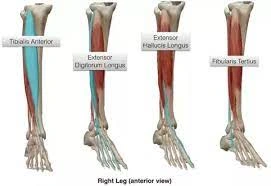
Tibialis anterior muscle
- Introduction; The tibialis anterior is a muscle in humans that arises along the upper 2/3rd of the lateral surface of the tibia & inserts into the medial cuneiform & first metatarsal bones of the foot. It works to dorsiflex & invert the foot. This muscle is mostly located near the shin.
- Origin: Lateral condyle & upper half or 2/3 of the lateral surface of the body of the tibia
- Adjoining part of the interosseous membrane
- The deep surface of the fascia.
- Insertion: Medial & under the surface of the 1st cuneiform bone, & the base of the first metatarsal bone
- Function: The tibialis anterior is the medial muscle of the anterior compartment of the leg. It is responsible for dorsiflexing & inverting the foot, & the largest dorsiflexor of the foot. The Tibialis anterior muscle has 2 origins, one being the lateral tibial condyle & the other being the upper lateral surface of the tibia, & inserts on the medial surface of the medial cuneiform & adjoining portion of the base of the first metatarsal of the foot allowing the toe to be pulled up & held in a locked position.
- Nerve supply: The tibialis anterior muscle is supplied by the deep fibular nerve (L4, L5), a branch of the common fibular nerve.
- Blood supply: The body of the muscle is entirely supplied by the branches of the anterior tibial artery; anterior muscular, medial muscular branches & anterior tibial recurrent artery
Extensor hallucis longus
- Introduction: The Extensor hallucis longus is a thin muscle, situated between the Tibialis anterior & the Extensor Digitorum Longus in the anterior compartment of the lower leg. It provides the only active extension force to the interphalangeal joint & the primary active extension force to the metatarsophalangeal joint.
- Origin: From the middle 2 quarters of the anterior part of the fibula & the adjacent interosseous membrane.
- Insertion: Extensor hallucis longus passes deep into the extensor retinaculum before inserting at the base of the distal phalanx of the big toe.
- Function: The main function of the extensor hallucis longus muscle is the extension of the big toe (hallux). This action happens in both metatarsophalangeal & interphalangeal joints of the hallux. This extension is a crucial movement in walking & running.
- Blood supply: The blood supply for the extensor hallucis longus muscle mainly comes from the anterior tibial artery & its branches. In further, the muscle can be supplied by the branches of the fibular artery.
- Nerve Supply: Deep peroneal nerve L4, L5.
Extensor digitorum longus
- Introduction: The Extensor digitorum longus is a feather-like muscle of the anterior (extensor) compartment of the leg. Besides the extensor digitorum longus muscle, this compartment also contains the tibialis anterior, extensor hallucis longus 7 fibularis (peroneus) tertius muscles.
- Origin & insertion: It arises from the lateral condyle of the tibia; from the upper 3-quarters of the anterior surface of the body of the fibula; from the upper portion of the interosseous membrane; from the deep part of the fascia; & from the intermuscular septa between it & the tibialis anterior on the medial, & the peroneal muscles on the lateral side. Between it & the tibialis anterior are the upper portions of the anterior tibial vessels & deep peroneal nerve.
- Function: The primary function of the extensor digitorum longus is to extend the lateral 4 toes at the metatarsophalangeal joint. This means that when acting independently, it is unable to extend the whole length of the toes, extending only at the metatarsophalangeal, while at the interphalangeal joints the toes remain flexed. However, contracting together with lubricants which are the main extensors of the interphalangeal joints, this muscle contributes to extension at every joint between the bones of the lateral 4 toes.
- Nerve supply: The extensor digitorum longus is innervated by the deep fibular nerve (L5, and S1), a branch of the common fibular nerve.
- Blood supply: The leg part of the muscle is supplied by 2 arteries of the leg; the proximal part is supplied by the anterior tibial artery, while the distal part receives blood from the fibular artery.
Fibularis tertius muscle
- Introduction: The Fibularis tertius muscle, also known as peroneus tertius, is situated on the lower lateral aspect of the leg. It is a portion of the leg’s anterior, or extensor, compartment, together with 3 additional muscles; extensor digitorum longus, extensor hallucis longus & tibialis anterior. They are responsible for ankle dorsiflexion.
- Origin and insertion: Fibularis tertius originates from 3 locations:
- Is a direct attachment of the extensor digitorum longus muscle from the distal 3rd of the medial surface of the fibula.
- The anterior part of the interosseous membrane connects the tibia to the fibula. It divided the anterior from the deep posterior muscles of the leg.
- Function: Due to its poor mechanical leverage, fibularis tertius can produce only 2 weak motions:
- Foot dorsiflexion around the talocrural joint, and with the help of extensor digitorum longus & tibialis anterior muscles.
- Foot eversion at the subtalar joint with the help of fibularis longus & fibularis brevis muscles.
- Nerve supply: Fibularis tertius is supplied by the deep fibular nerve, a branch of the sciatic nerve. It originates from the L5 & S1 spinal nerves.
Dorsiflexors muscle stretching exercise
- Standing Shin Stretch
- Kneeling Shin Stretch
- Seated Shin Stretch
- Lying Shin Stretch
- Toe walking
- Ankle ABC’s
- Manual Toe Stretching
- Hammer Toe Finger Splint
- Rolls

Standing Shin Stretch
How to do:
- Stand tall. You require to use a hand on a wall & other support for balance.
- Slightly bend both knees.
- The right foot remains squarely on the floor. The foot is to be stretched or the left foot is put just behind this stable & right foot, with the toe of the left foot touching the ground.
- Keeping the toe firmly on the ground, pull the left leg forward so you feel a stretch from the top of your left foot through the shins.
- Once you feel a stretch, hold it for 10-30 seconds.
- Repeat the stretch with the right foot.

Kneeling Shin Stretch
How to do:
- Kneeling can be used for gradually stretching the shins muscle.
- You must have good knee flexion to do this stretch as you will be sitting on the heels. If it causes pain in the knees, don’t perform it.
- Kneel on a mat with the tops of the feet flat on the floor & the buttocks over the heels.
- You feel stretching on the shin.
- Hold for 10-20 seconds.
Seated Shin Stretch
How to do:
- Sit on a chair. Drip the knee towards the floor so the toe of the foot is extended into the ground as in the standing stretch.
- Slowly pull forward while the toe is planted on the ground, same as the standing stretch but seated.
- Hold for 10-20 seconds.
- Repeat for both feet.
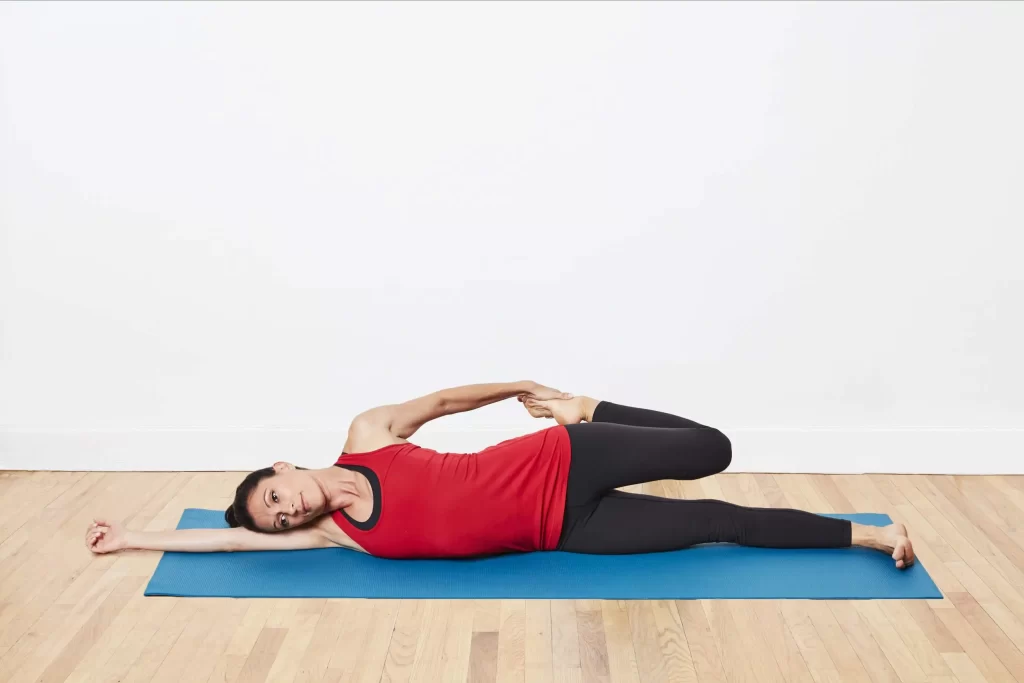
Lying Shin Stretch
How to do:
- The lying Shin Stretch stretch is alike to the lying quadriceps stretch.
- Lie on the side-lying position. At present, bend the upper knee so the foot is behind the back.
- Come to the back & grasp the forefoot, pulling it towards the back.
- Hold for 10-20 seconds.
- Repeat for both feet.
Toe walking
How to do:
- Stand tall. In walking transfer the body weight onto the toes & heels off the floor.
- Then walk on the toes which allows you dynamic shin stretch.
- You can utilize the wall for support throughout the walk.
- Walk for 1-2 minutes.
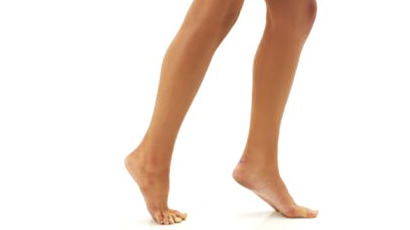
Ankle ABC’s
- How to do: Moving the ankle in multiple directions is one way to slowly stretch the Dorsiflexors muscle.
- Take a comfortable sitting position with the feet unsupported. Remove your shoes & socks.
- Gradually draw the alphabet in the air, leading with the big toe. Take as far as possible in each direction. Never allow the knee to move — all movement might come from the ankle.
- Every time the foot is pointed downward, you might feel a pulling sensation along the front of the shin.
- Recurrent the alphabet 2-3 times on both legs.
Manual Toe Stretching:
- You can also use a towel to stretch the toes. Sit on the floor with the legs perfectly outstretched & a towel wrapped properly around your toes. Make sure that you hold the towel ends with your hands & pull the toes towards you. maintain yourself in this position for 20 to 30 seconds. You can also forgo the towel if you like & try pulling the toes by using your hands.
Toe Taps:
- This toe exercise helps to stretch the joint. As you sit in a comfortable chair, gently extend the big toe towards the ground as you try to point the other toes up. hold onto that position for about a second & then tap them lightly back down to the floor. Recurrent this about 10-12 times & then reverse this process by gently pulling the big toe up as you keep the other toes on the floor.
Hammer Toe Finger Splint:
- The claw Toe Finger Splint is also referred to as “squeeze” & involves using the fingers for creating little splits between the toes for stretching them. Sit in a comfortable position & then bring one foot up & then place it right on your opposite thigh. Then slide the fingers gently in between the toes, gently pinching the fingers for squeezing the toes together. Repeat the exercise 12 times. If you like you can perform each toe simultaneously by putting one finger between them & pinching.
Rolls:
- This particular claw toe exercise involves tapping the toes gently on the floor from one side to the other. First, stand barefoot on some flat surface && try lifting all the toes off the ground, while making sure that you keep the heel planted. Now bring the toes gently down on the surface one by one, starting with the small & then ending with the big. Repeat the exercise 10 times & then move in the opposite direction.
Health Benefits of Dorsiflexors muscle stretching
There are many type benefits you might know:
- Reduce the risk of injury to calves, ankles & feet
- Reduced chance of getting tibialis anterior tendonitis
- Better ground clearance when walking to avoid tripping
- Reduce the risk of growing shin splints & stress fractures
- Fast-up recovery of shin splints.
- Increased athletic performance in sports where the ankle is “locked” like in soccer to kick a ball
- Increases the ankle range of motion. such as dorsiflexion, inversion, & adduction.
- It also maintains the medial arch of the foot.
- It also helps in the anticipatory postural adjustment part during gait beginning tibialis anterior perform knee flexion at the stance limb by causing forward displacement of the tibia.
- It also helps in eccentric deceleration of foot plantar flexion, pronation & eversion.
Strengthening exercise of Dorsiflexors muscle
- Seated Elastic Band Exercise
- Cuff Weight Exercise
- Isometric Exercise
- Seated Calf Stretch
- Seated Toe Raises
- Wall Toe Raises
- Heel Walk
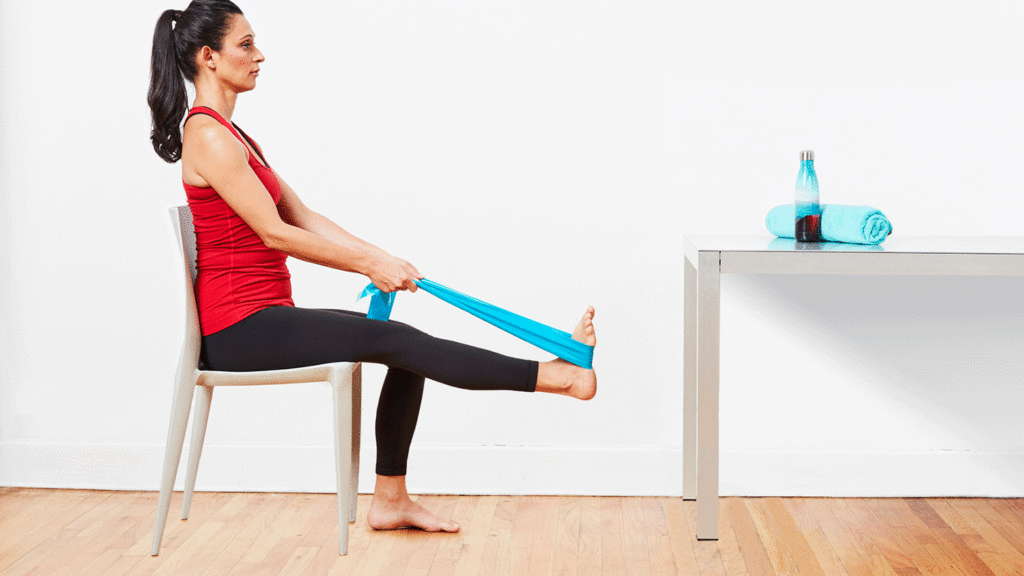
Seated Elastic Band Exercise
How to do it?
- For the Seated Elastic Band Exercise exercise, you need an elastic resistance band.
- To perform the Seated Elastic Band Exercise exercise you have to Sit on the floor with the leg extended in front of you. now Alternatively you can sit on a chair with the foot propped up on another chair.
- Wrap a resistance band over the ankle. Attach one end to a stable object like the leg of a table, & secure the other around the foot near the toes. It may be helpful to have the lower leg resting on a small pillow so the heel of the foot does not rub on the floor.
- To perform this exercise Pull the toes & foot up while keeping the knee extended. The ankle might be moved as you flex the foot up
- Pull the foot up as much as you can, & hold the end position for 2 seconds.
- Slowly relax back to the starting position.
- Do this exercise for 10-20 repetitions or until the anterior tibialis muscle tires & you can no longer flex the ankle up.
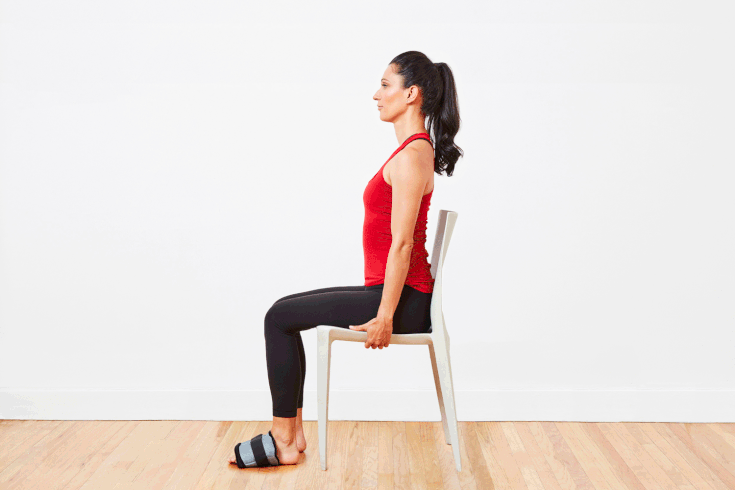
Cuff Weight Exercise
How to do it?
- For Cuff Weight Exercise you need a cuff weight.
- A cuff weight is a padded weight that you can wrap around the ankle. for Cuff Weight Exercise you have to sit in the chair & wrap a cuff weight around the toes. Make sure it is secure. Let the footrest on the floor, start this exercise by sitting with the cuff weight on the foot & then flexing the ankle so the foot & toes move up towards the knee.
- When the foot is flexed up, hold the position for 2 seconds,
- Gradually lower your toes back down to the initial position.
- Repeat the exercise for 10-20 repetitions.
Isometric Exercise
How to do it?
- Isometric exercise is a type of movement in which you push against an object you can not move. It is simple to do, & it can help strengthen the muscle in specific ranges of motion (ROM) in the ankle.
- To do isometric anterior tibialis strengthening you have to Sit in a chair & lie down.
- Cross 1 leg over the other with the affected leg on the bottom.
- Put the foot on top of the ankle you wish to exercise.
- Press the top of your weak foot into the sole of the other foot. Press down with the powerful foot to resist it. Remember, that movement occurs from the foot not from the ankle.
- Hold this position for 5 seconds, & then slowly release. Perform about 10 -15 repetitions of the exercise, 2 – 3 times a day. Isometric exercise can help to strengthen the muscles, but strength only occurs in the specific ROM in which you are exercising. That means that you might vary the position of the ankle when performing the exercise.
Seated Calf Stretch
How to do it?
- If your anterior tibialis muscle is weak, then you have difficulty flexing the foot. This means you have a shortened calf. A shortened calf will be a tight muscle, so stretching the calf may be necessary to correct the foot drop fully.
- To perform this exercise you have to Wrap a towel around the ball of the foot, & the knee should be extended.
- Pull the ends of the towel so your foot flexes up & stretches your calf.
- Hold the stretch for 15-30 seconds.
- Relax. Perform this 3 times.
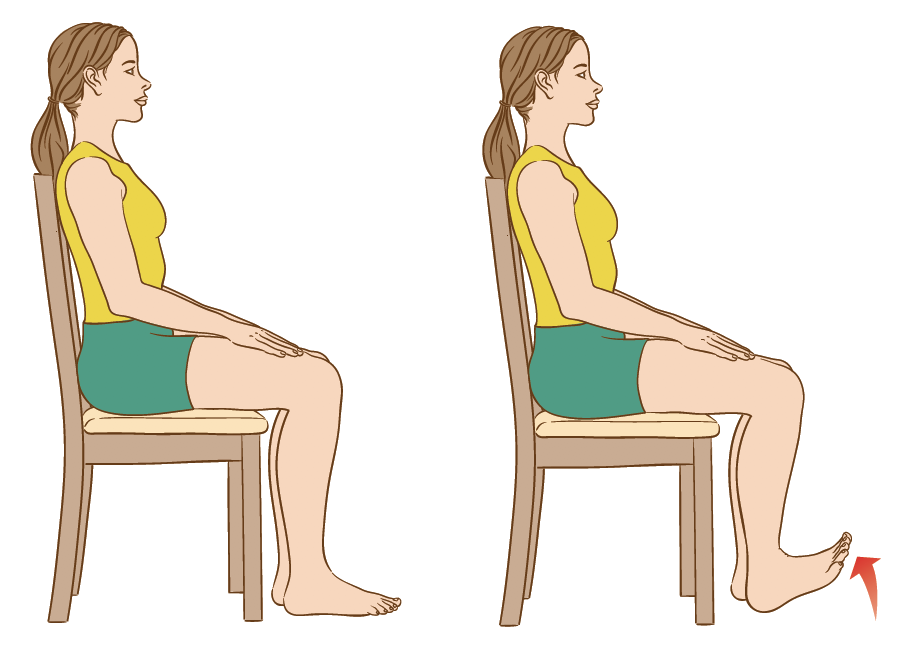
Seated Toe Raises
How to do it?
- For the Seated Toe Raises exercise, you have to Sit on a chair with the feet placed in front of you
- Now gradually raise your toes off of the ground.
- Hold for 2-5 seconds at the top
- Repeat for 2 -3 sets of 20-25 repetitions
Wall Toe Raises
How to do it?
- For the Wall Toe Raises exercise, you have to Stand 12-15 inches away with the back towards the wall with the feet hip-width apart.
- the knees might be slightly flexed then lean back into the wall.
- Elevate the toes off the floor & hold at the top for 2-4 seconds then lower the toes back to the floor.
- Repeat for 2-3 sets of 15-20 repetitions

Heel Walk
How to do it?
- For the Heel Walk exercise, you have to stand on both feet hip-width apart with no shoes on.
- Elevate the toes off the floor so that your heels are in contact with the floor.
- Walk forward while leaning back and placing weight on the heels.
- Do this for 30-40 seconds.
- Repeat this 2 to 3 times.
When did you not do the Dorsiflexors strengthening exercise?
- If you feel any pain during this exercise then do not do this exercise.
- If you are already suffering from foot & ankle pain.
- If your doctor advised you to take rest.
- If the lower limb bones are recently fractured.
Health benefits of Besides Dorsiflexors strengthening exercise:
- Assist to Reduce the risk of injury to the calf, foot, & ankle joints.
- Assist to reduce the chance of getting Besides Dorsiflexors tendonitis.
- Assist to increase ground clearance when walking to avoid tripping
- Reduce the risk of growing shin splints & stress fractures
- Speed up recovery of shin splints.
- Boost player performance in sports where the ankle is locked like in soccer to kick a ball
What are the safety & precautions of doing the Besides Dorsiflexors exercise?
There are some safety measures you require to look for:
- Don does not bounce during the stretch. it causes injuries to the muscles. Such as strain.
- Never overstretch a Besides extensor digitorum long muscle.
- Do not perform it so many times, it causes fatigue to the muscle. You might use a suggested time of repetition
- The holding time of the stretch should be recommended by your therapist which is normally 30-60 seconds.
- Never perform a stretch on the prior injured part of the body. Such as fractures, sprains, etc.
- Never stretch cold muscles, it causes pain. stretch it once you warm up the muscle.
FAQ
Dorsiflexion of the Foot (pulling the foot upwards towards the leg): Performed by the tibialis anterior, extensor hallucis longus & extensor digitorum longus.
To do the exercise, lean the hips forward as you keep the right foot flat on the floor. Allow your knee to move past the stick & hold the position for 1 second. Repeat 3 sets of 12 repetitions on both legs.
Dorsiflexion happens in your ankle when you draw your toes back toward the shins. You contract the shinbones & flex the ankle joint when you dorsiflex your foot. You can also dorsiflex the foot by lifting the ball of your foot off the ground while standing, keeping the heel planted into the ground.
This 1 muscle on the front of the leg for dorsiflexion, tibialis anterior. There are 3 on the back of the leg for plantar flexion, gastrocnemius, soleus, & plantaris. Here’s the tibialis anterior. Tibialis anterior arises from the lateral surface of the upper tibia, & from the interosseous membrane.
Working on increasing flexibility/decreasing tone of the gastrocnemius & soleus muscles of the calf can & will improve ankle dorsiflexion. Some of the popular methods to do this include stretching, soft tissue massage, ultrasound, heat, cupping, & instrumented-assisted soft tissue mobilization.

